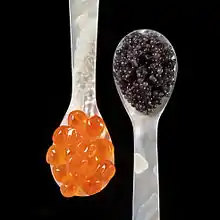Caviar spoon
Caviar spoons are traditionally made of inert materials, such as animal horn, gold, mother of pearl,[1] and wood.[2] They range in length from 7 to 13 cm (2.7 to 5 in), and have a small shallow bowl that may be either oval or paddle shaped.

Mother of pearl caviar spoon

Mother of pearl caviar spoon, 14 cm (5 1⁄2 in), with engraved sterling silver handle
There is a custom that caviar should not be served with a metal spoon, because metal may impart an undesirable flavour.[3] Though caviar is stored and sold in metal tins, non-reactive interior linings are put in place to prevent any adverse effects.[4] Silver spoons are reactive, however, and thus may affect the flavor.[5]
References
- Wolke, Robert L. (2002). What Einstein Told His Cook: Kitchen Science Explained (1st ed.). New York: W.W. Norton. p. 163. ISBN 0393011836.
- "History of Cutlery: History of the Spoon". =Eating Utensils. Retrieved 25 April 2014.
- Tesauro, Jason and Phineas Mollod (2002). The Modern Gentleman (2nd ed.). [Berkeley, Calif.]: Ten Speed Press. p. 48. ISBN 9781607740063.
- Chandra, Gowri. "5 Myths About Eating Caviar and How to Unlearn Them". foodandwine.com. Retrieved 7 March 2020.
- Burnside, Margaret Word (Jan–Feb 2010). "Ask Margaret: Why can't caviar be served with metal spoons?". Tampa Bay Magazine. 25 (1). Retrieved 14 November 2012.
This article is issued from Wikipedia. The text is licensed under Creative Commons - Attribution - Sharealike. Additional terms may apply for the media files.

